The denim jacket is a staple for many men (and women!) today, and this is partly because of its versatility. Due to its surge in popularity over the last few decades, though, it’s often worn in trendy ways that don’t harmonize with classic menswear. But the jacket has a rich history, and definitely has a place in a timeless wardrobe–if worn correctly! We’ll show you how today.
Quintessentially an American piece of clothing, the denim jacket is worn and loved by celebrities, fashion icons, and many others not just in the US, but all over the world. But beyond this fact, denim has both good and bad spots in history! Let’s dive right into that, as well as share some fool-proof style ideas here!
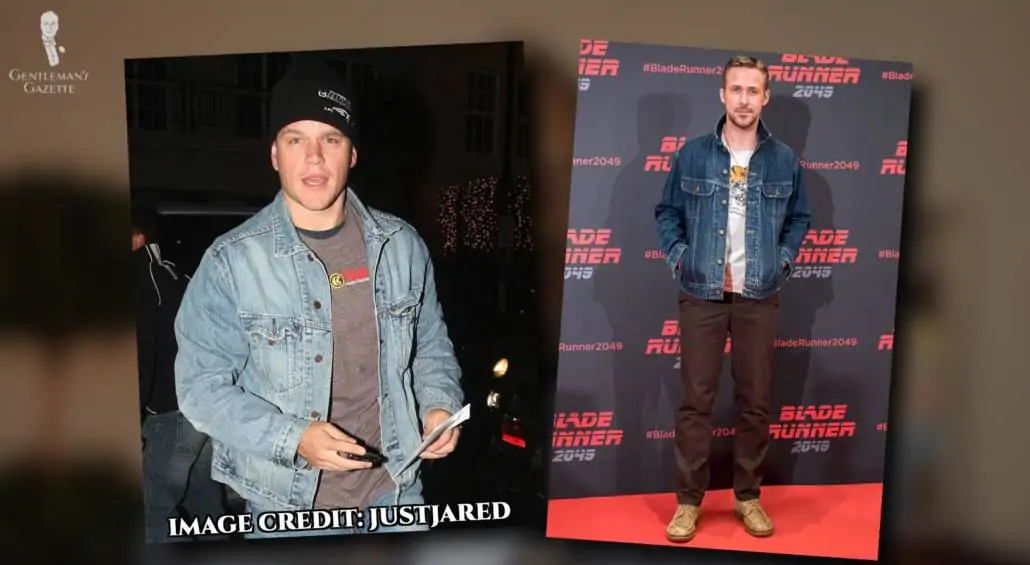
History of the Denim Jacket
Remarkably, the denim jacket is still quite new in terms of fashion history, especially when compared to other items like suits, which have been around for quite some time.
Making its first appearance in 1880, the denim jacket was first introduced by Levi Strauss, only 10 years after the introduction of the famous Levi’s jeans.
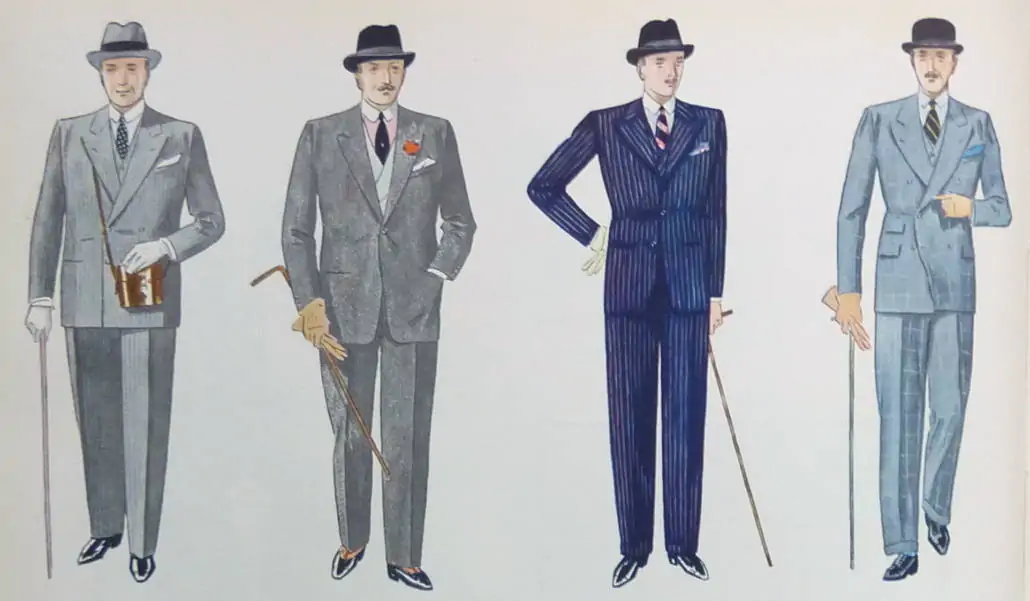
Splitting the previous workwear style of overalls into two items, jeans for the bottom and a jacket for the top, allowed for greater freedom of movement for miners, railroad workers, and other hard labor jobs. Plus, the jacket could actually be removed to better regulate body temperature when needed.
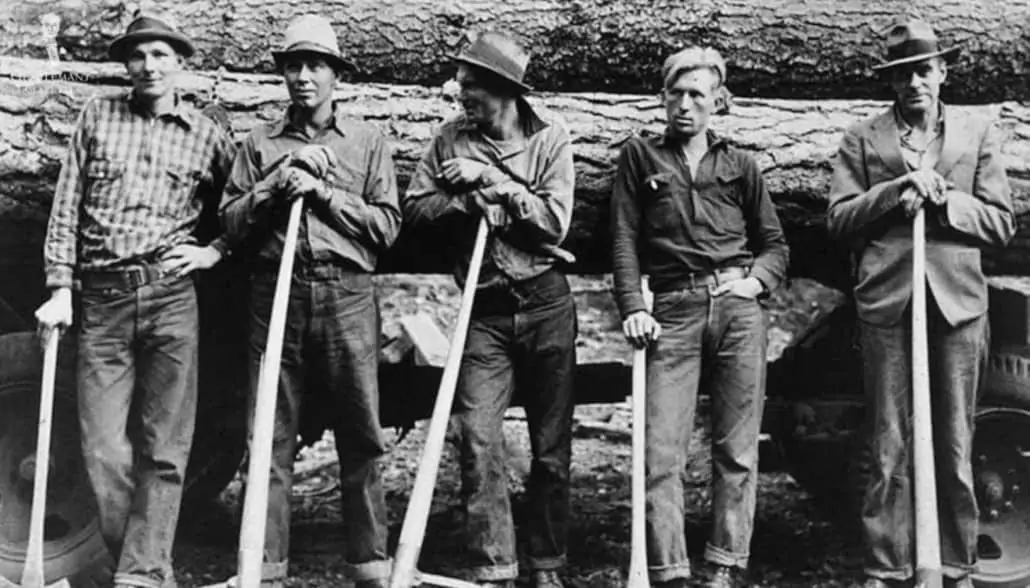
Being such a hard-wearing and cost-effective fabric, denim was the perfect choice to construct a workwear jacket. After all, it had proved to be a great choice with the jeans the decade before. And you know what they say, “If it ain’t broke, don’t fix it.”
As the decades progressed, other denim manufacturers continued to evolve and adapt the denim jacket as well. In 1921, Lee introduced the Railroad Jacket, specifically designed for, you guessed it, railroad workers.
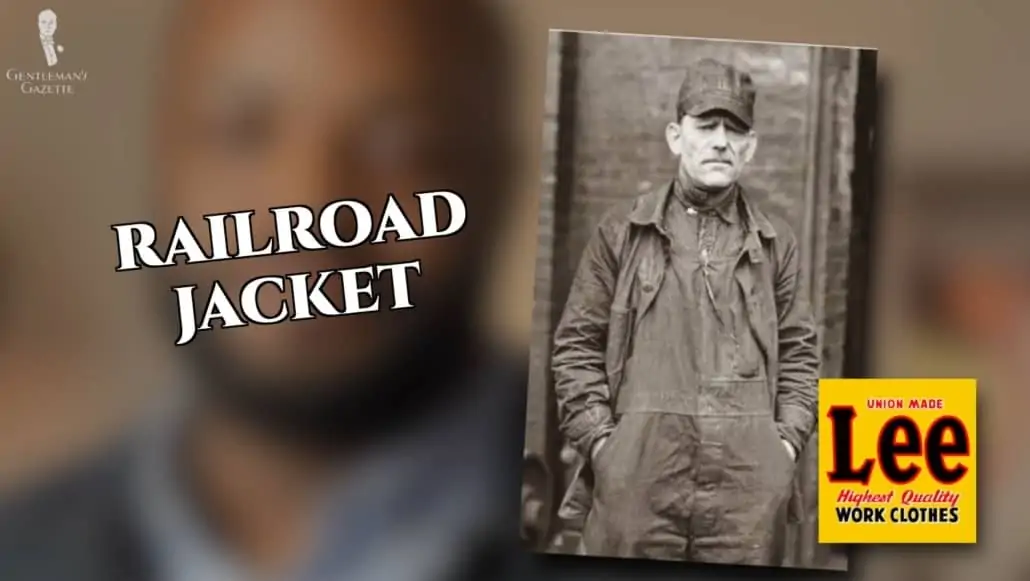
Then, they innovated the design specifically for cowboys and cattle workers, called the Slim Jacket. This style was shorter than previous iterations. The shorter length helped it to not be so restrictive. It had slanted pockets, which made access easier for riders who were on their horses.
An alternative version to the Slim Jacket called the Storm Rider was introduced in 1933. This jacket featured an Alaskan blanket-styled lining, and it added corduroy trim to the collar and cuffs for extra warmth. This iconic style continues to this day, and it’s become the go-to denim jacket for wintertime.
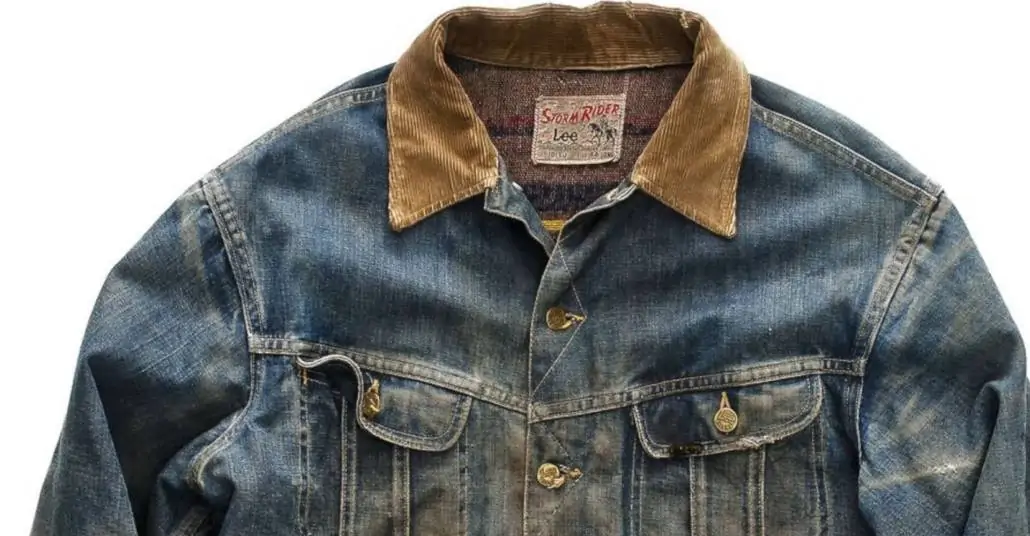
Not ones to rest on their laurels, Levi’s had also been refining their denim jackets. The Type III introduced in 1953 is another iconic style you might recognize. This featured flapped chest pockets, a tailored fit, and it also had waist straps to the back. This style became affectionately known as the Trucker Jacket.
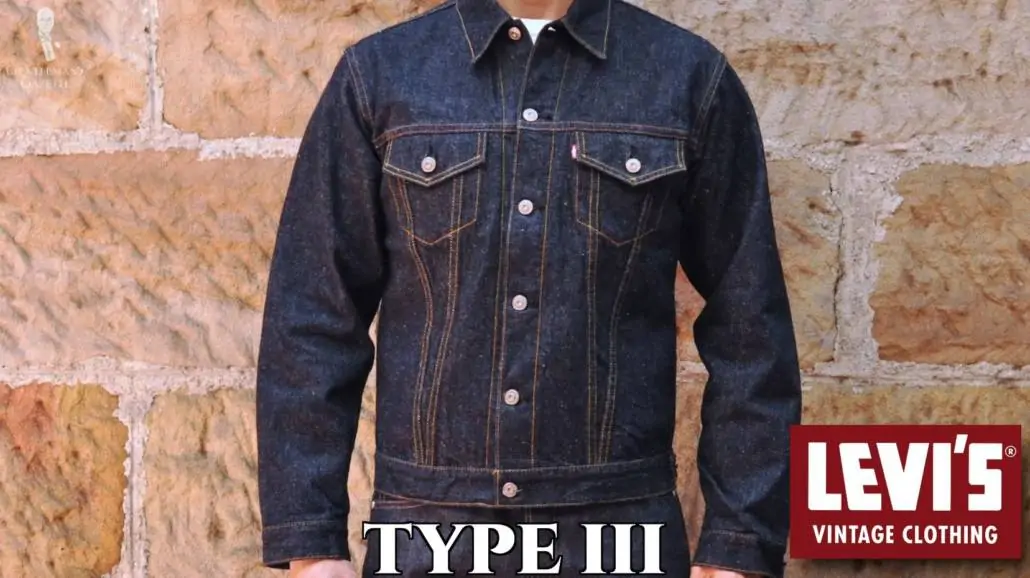
The early 50s saw the beginning of the counter culture movement in America with movies, such as The Wild One and Rebel Without A Cause, featuring Marlon Brando and James Dean, respectively, wearing casual clothing and worker items as a symbol of rebellion against societal norms.
So, when Elvis Presley famously appeared in the movie Jailhouse Rock in 1957 wearing a dark denim jacket, a huge rise and the jacket’s popularity occurred and the denim jacket was now an accepted item of clothing for men and women alike.
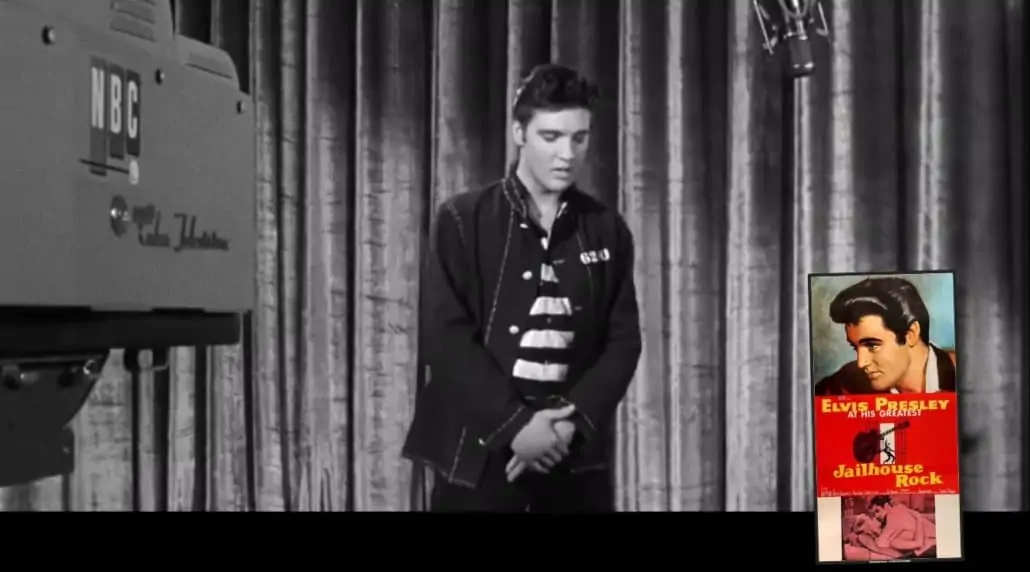
The 60s saw Hollywood icon Marilyn Monroe enjoy the jacket as a nice break from her Hollywood gowns. John Lennon was a huge fan of the denim jacket throughout the 70s. And, of course, Bruce Springsteen’s unforgettable, iconic take on the denim jacket, which was worn sleeveless over the iconic biker jacket for his 1984 album Born In The USA.
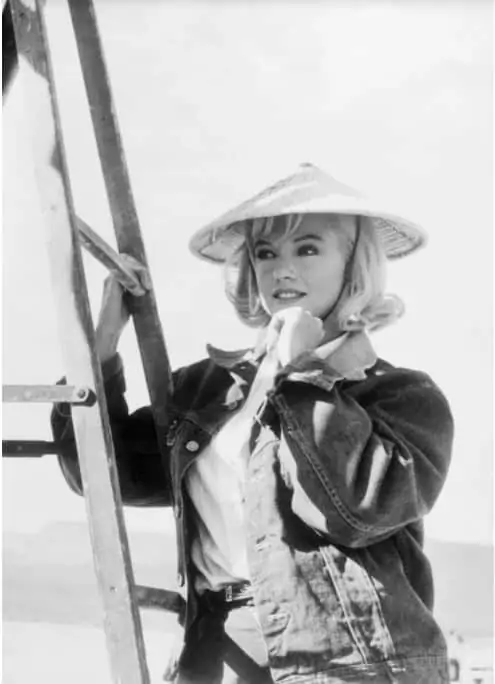

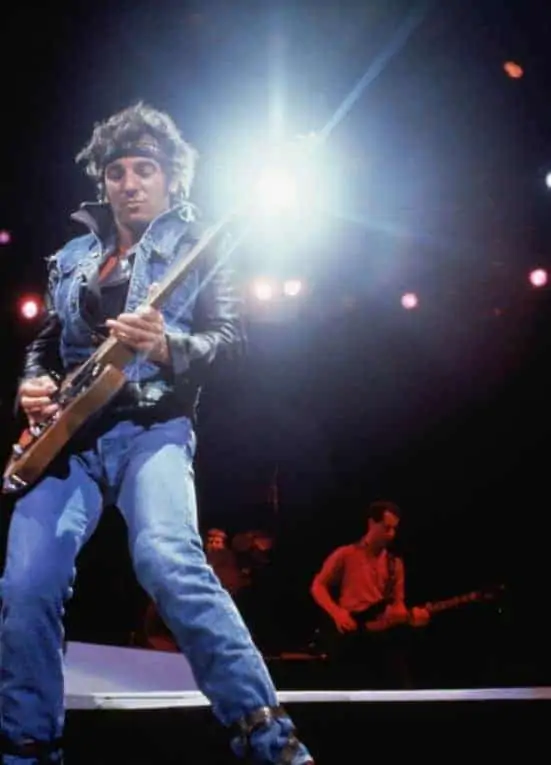
Who knew there could be so much rebellion in one outfit? And, of course, in recent decades we see that the denim jacket popularity continues to grow. It’s a part of the 90s oversized trend, as well as the 2000s “denim the heck out of everything” trend, and so, the denim jacket lives on today, as a continued symbol of expression, freedom, and generally as a great piece of casual wear.
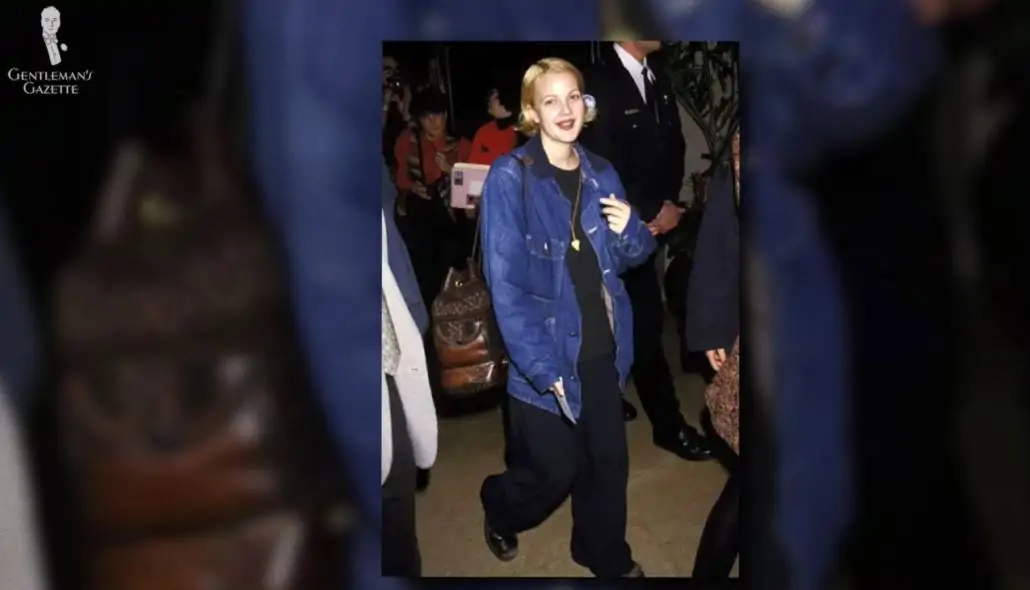
What Makes A Good Denim Jacket?
1. Quality Denim
It goes without saying, but the first thing you should be looking for is the denim jacket that’s crafted from top-notch denim. So, we’re talking about 100% cotton denim, as cotton is a great natural fiber. It’s also hard-wearing when woven into denim. This material breathes well and gets better with age.
Remember, not all denim is made the same. Some manufacturers will add man-made fibers into the mix to make the fabric cheaper, or to improve the initial feel of a garment. This is often the case with elastic, as clothes that have a stretch to them feel better because they move with your body, but they won’t last as long as proper cotton denim.

A unique feature of denim is to become more comfortable with age. Another trick that is often used is in the quality of the weaving itself. When cotton is spun, the fibers are brought together into a tight thread. Typically, the tighter the thread the more durable it is. When it’s tight, it’s harder for the fibers to loosen and fray.
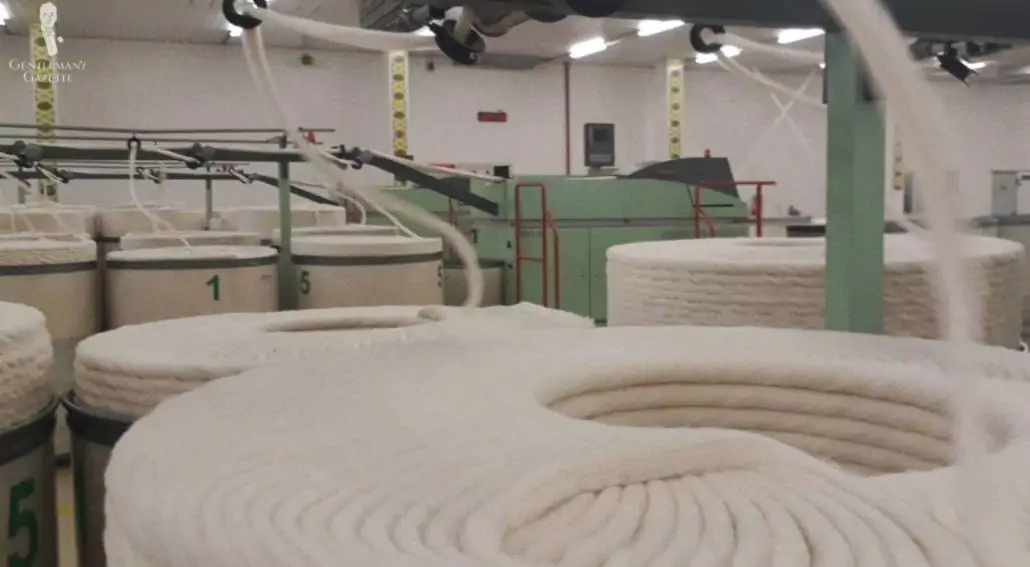
So, if a manufacturer wants to create a softer feel straight away, they can choose to have loosely woven denim. This doesn’t mean that the denim in question will feel soft or straight out of the box, but it will also fray much easier than regular denim.
Selvedge Denim
Selvedge (also spelled selvage) or raw denim is an example of great quality denim. It’s a self-edged fabric, which is often proudly displayed to signify its quality. Selvedge denim is created on shuttle looms–a style of loom that was used in the manufacturing industry prior to the 60s, and before the introduction of projectile looms, or the modern-day fabric-making machines.
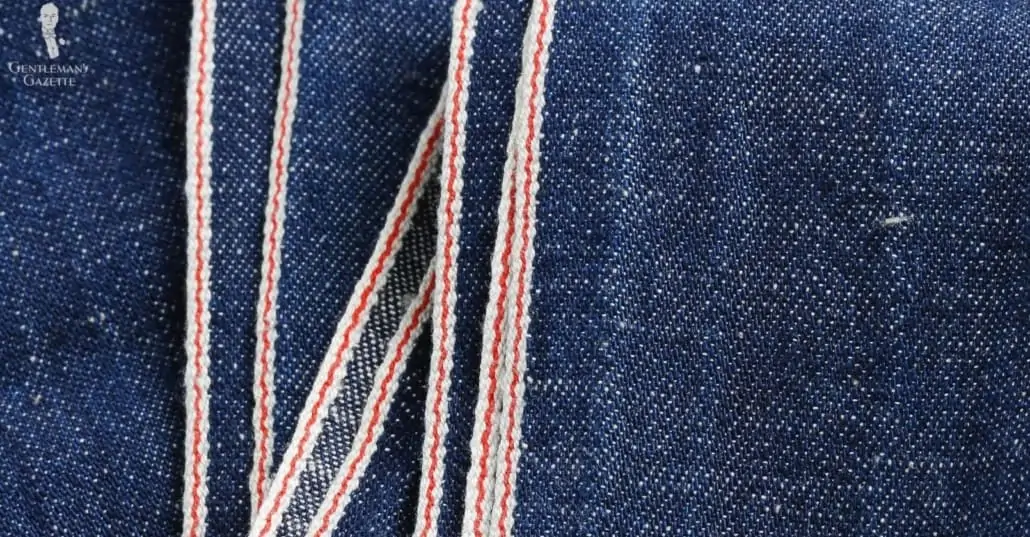
These older looms require an operator to oversee the fabric production, typically leading to an overall higher quality product. Selvedge denim has many benefits, including being very hard-wearing, softening beautifully over time. It also develops a worn-in patina that is unique to you. Of course, quality doesn’t come cheap, and denim is no exception.
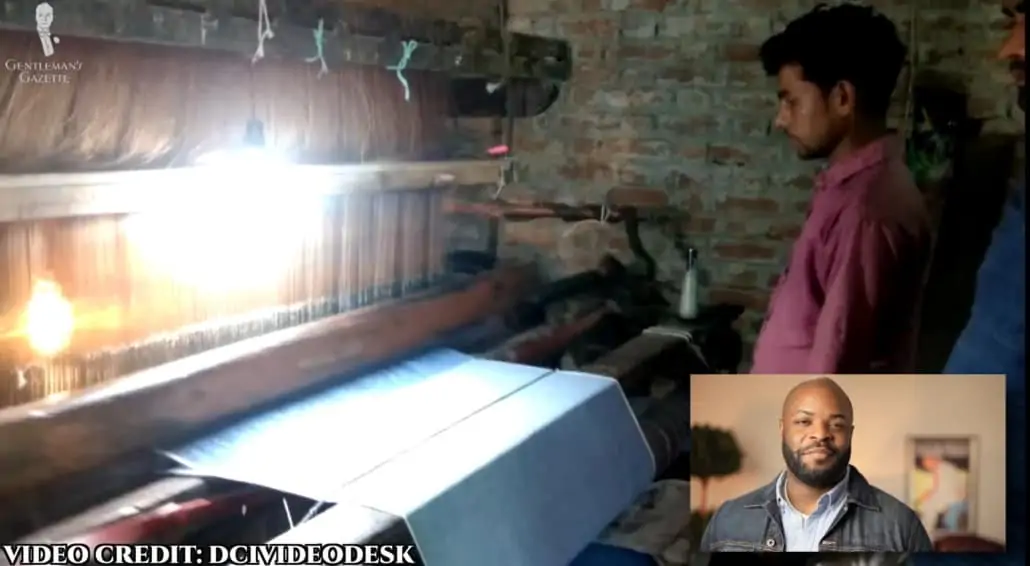
So, you can expect to pay a premium for a selvedge denim jacket, but the benefits should ultimately outweigh the upfront cost. One more word if you decide to choose a jacket made from selvage denim: it can be quite stiff, to begin with, depending on the thickness of the fabric. But don’t worry, this will soften as you wear it.
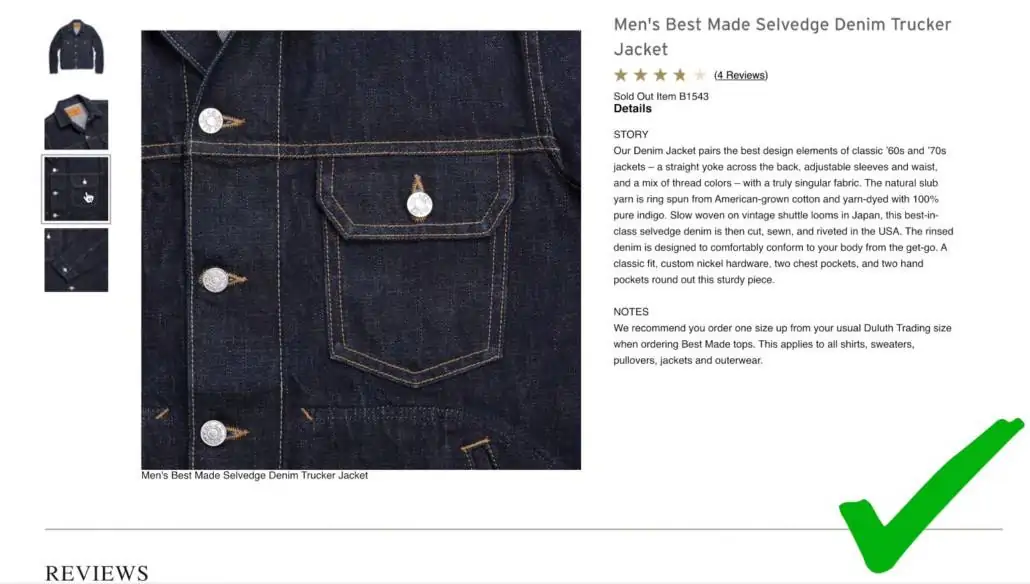
There’s the possibility of some shrinkage if you decide to wash the jacket but this is normal. This is something that the manufacturer should inform you of, though.
It’s also called “raw” denim, and it simply means that the deep indigo dye will have a tendency to come off on lighter garments. The shade of the garment will actually lighten over time, but this is part of the charm of selvedge denim.
2. Fastening & Stitching
Historically, copper was used for the rivets and buttons on a denim jacket, but as these oxidized and turned green, copper was replaced. So, nowadays, you’ll typically find that the hardware on a denim jacket is made from a metal alloy.
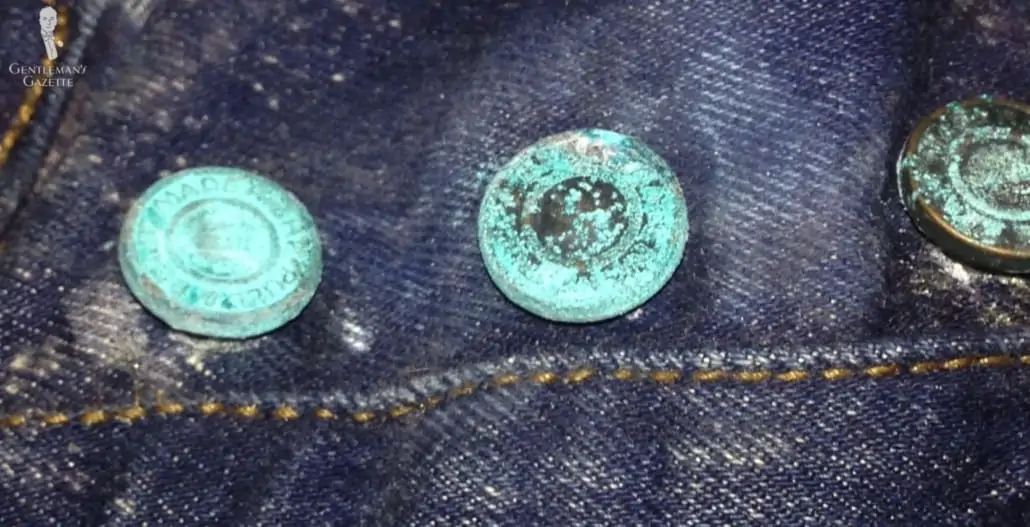
Basically, you’re going to want to look and make sure that the buttons and rivets on the denim jacket are fastened securely. Doing this will help ensure that it will stand the test of time. Rest assured, the buttons and rivets on your denim jacket can be replaced and repaired when needed.
The other area to look out for on a denim jacket is the stitching. Check to make sure that everything is even, and if the jacket is unlined or has any overclocking, check this, too. After all, nobody wants a wonky seam.
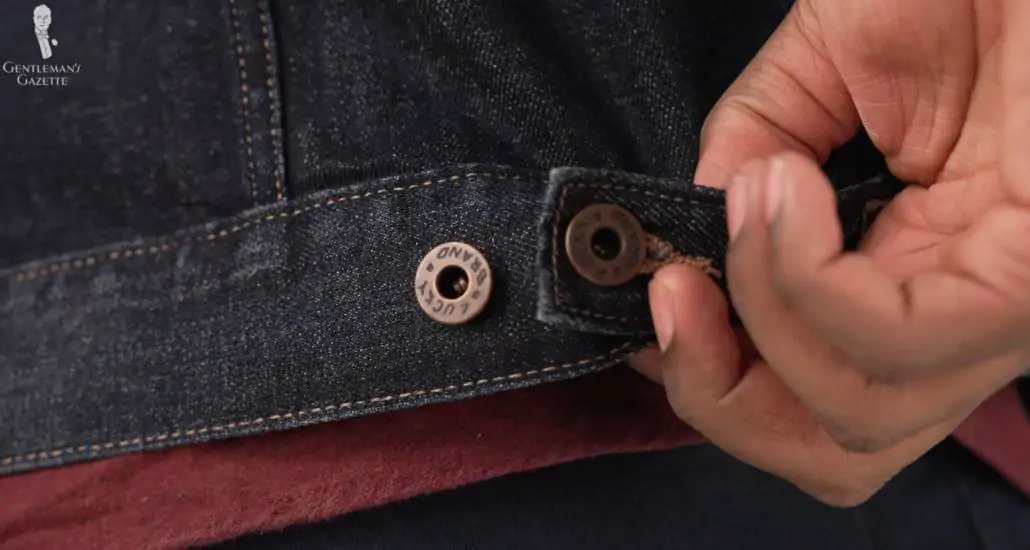
3. Fit
Lastly, and perhaps, the most important element to look at when adding a denim jacket to your wardrobe is the fit. Just because it’s casual clothing doesn’t mean you should pay any less attention to how it fits you.
Regardless of the style of jacket you prefer, it’s important to ensure that it follows the lines of your body well, but preferably without being skin tight. Because the skinny jeans trend has already happened, don’t follow it up with a skinny jacket!
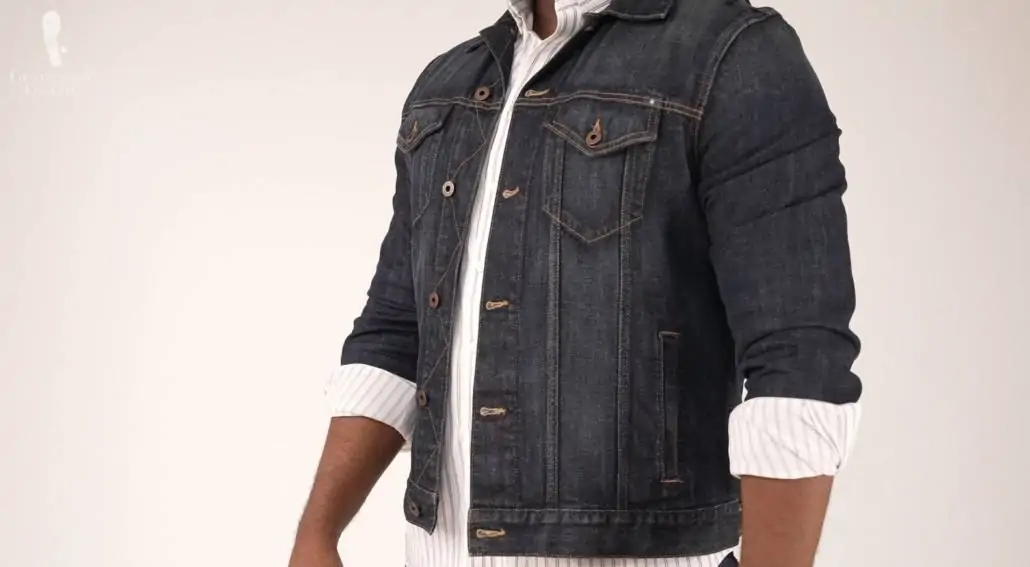
You don’t want it to be too large either. And, no matter how much you dig those 80s and 90s trends, they will come in and out of fashion in very mysterious ways. But, a well-fitting denim jacket will look great forever.

Interestingly, a lot of the principles of good fit are shared with the suit jacket as well, but, to sum it up, you should be able to comfortably button your jacket all the way, without sucking in your stomach. You should also be able to move your arms freely.
The sleeves should reach to approximately your wrist, no shorter and no longer. And the body length should meet the top of your hips for a good classic length.
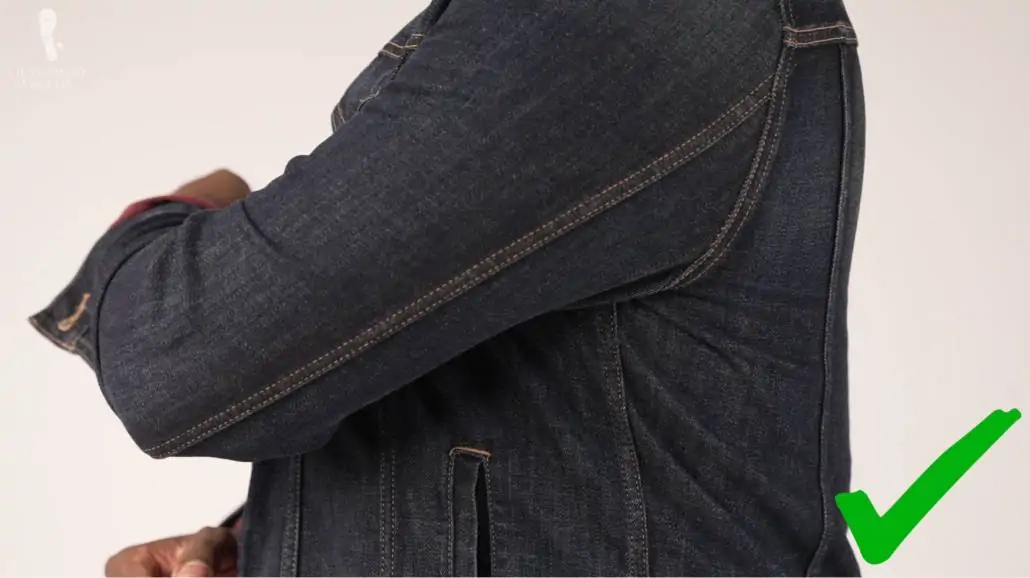
More Tips for Stylish Denim Jackets
Keep Things Simple
Like good food, the beauty of a denim jacket is in its simplicity. So, please steer clear of the manufactured rips and tears. Let those things happen by themselves; it’ll look much more authentic. And, avoid embellishments like studs, badges, or patches, as these kinds of things can make the jacket look like it belongs to a younger relative, instead of that stylish individual that you know you are.
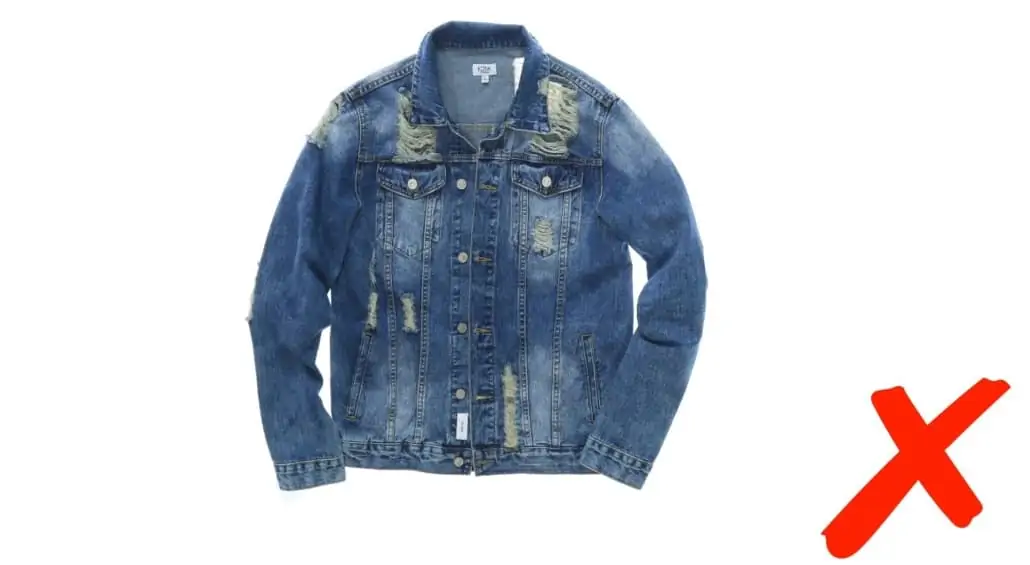
Classic Is King
We’ve got loads of great technologies and innovations in the 21st century, and that means you can find a denim jacket in just about any color. Instead, we advocate blue denim all the way. It’s classic, it’s timeless, and you’ll never look back on the photo and regret it.
Remember, the darker the blue the smarter it will look.
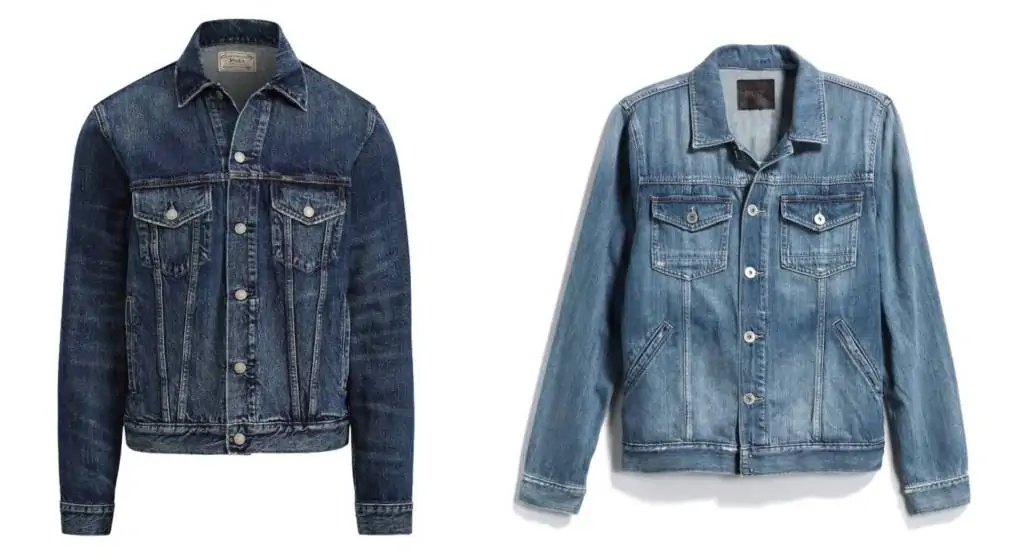
Avoid the “Canadian Tuxedo”
Finally, we can’t talk about denim jackets without mentioning the infamous Canadian Tuxedo. Legend has it that in 1951, Bing Crosby was denied entry into a Vancouver hotel due to his denim jacket and jeans combination. Levi’s responded by creating a tuxedo entirely out of denim for Bing, and the nickname “Canadian Tuxedo” stuck.
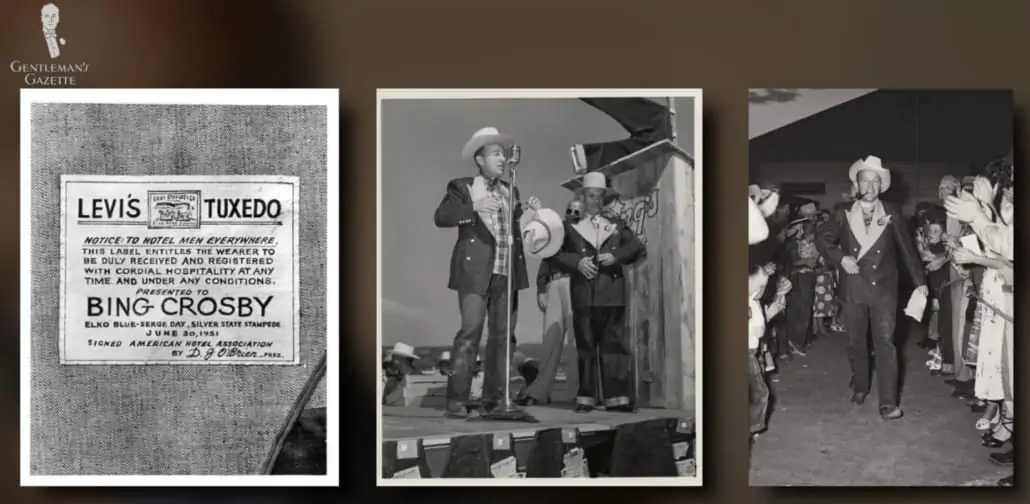
Nowadays, the term refers to matching your jeans and jacket exactly. And, since Bing’s appearance in double denim, this look has seen some less than fortunate outings.
A great way to get around a problematic combination is to ensure your denim doesn’t match. So, consider a light denim jacket with dark denim jeans, or vice versa.
How To Wear A Denim Jacket Anytime
Outfit #1: Flannel shirt, contrasting jeans, suede boots
Starting things off with a classic denim ensemble, we’re pairing some dark denim jeans with a classic denim jacket. As mentioned, the difference in color between the two denims creates contrast. Therefore, dispelling any notion of a Canadian tuxedo.
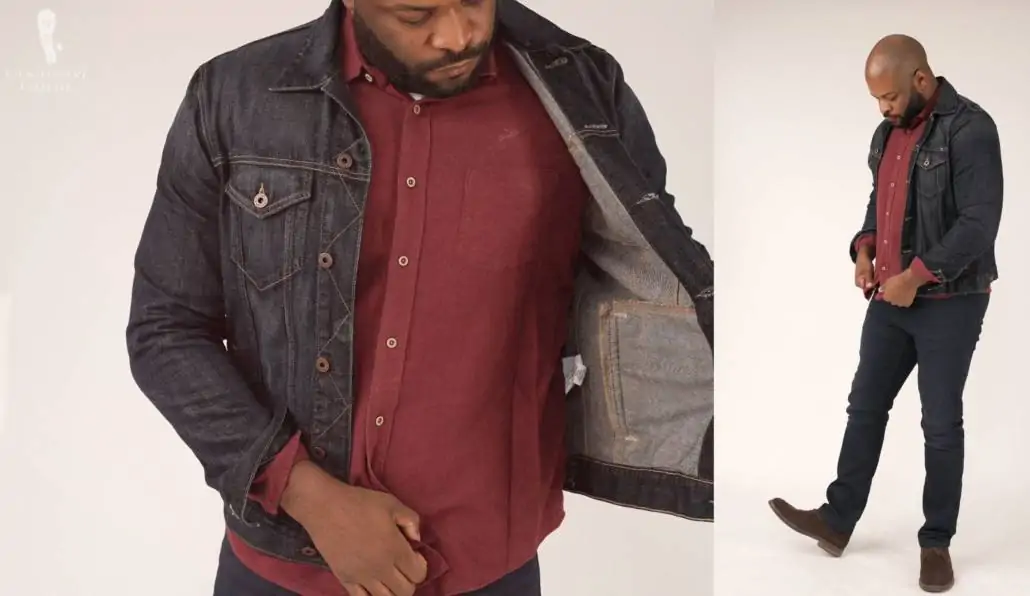
Furthering the traditional workwear feel to this outfit is a classic flannel shirt. The simplicity of this outfit is the key to its success. So, this is why accessories are kept minimal with the brown leather belt and suede chukka boots to finish off this ensemble. After all, you just can’t beat this classic look.
Outfit #2: White t-shirt, chinos, white sneakers
Next, we have a simple and modern way to wear your denim jacket, all while still looking classically cool. This time, we’re using a pair of khaki-colored chinos as the accompanying bottom to the denim jacket. The natural light brown tones and the trousers work really well against the blues in the jacket.
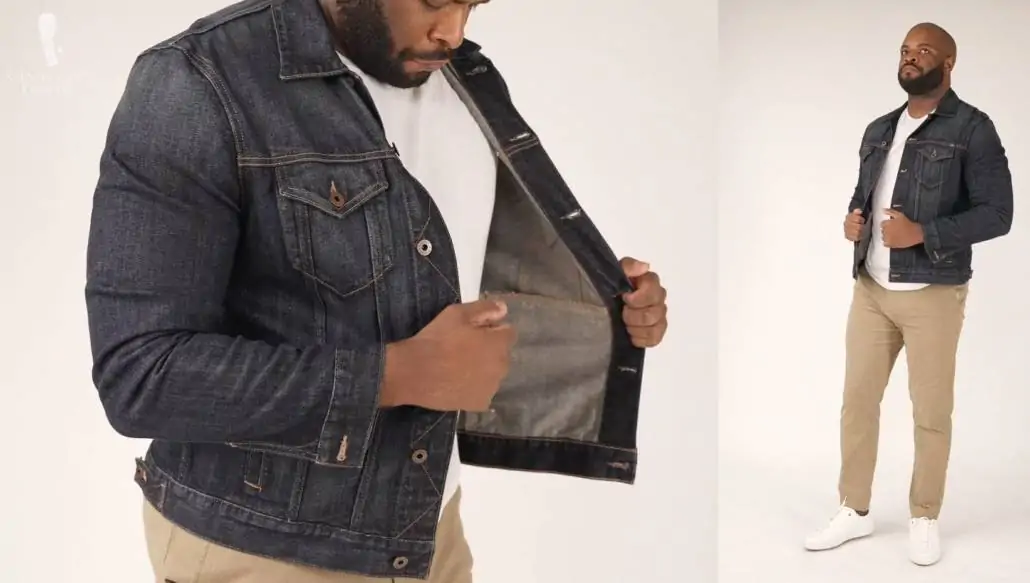
The concept of mixing browns and blues is explained further in our color pairing guide, and this harmony is furthered by adding a darker brown belt to the outfit.
Underneath the jacket, a simple white T-shirt, less formal than a button-up dress shirt, but more formal than a slogan t-shirt. A white T-shirt strikes the balance of formality in this outfit.
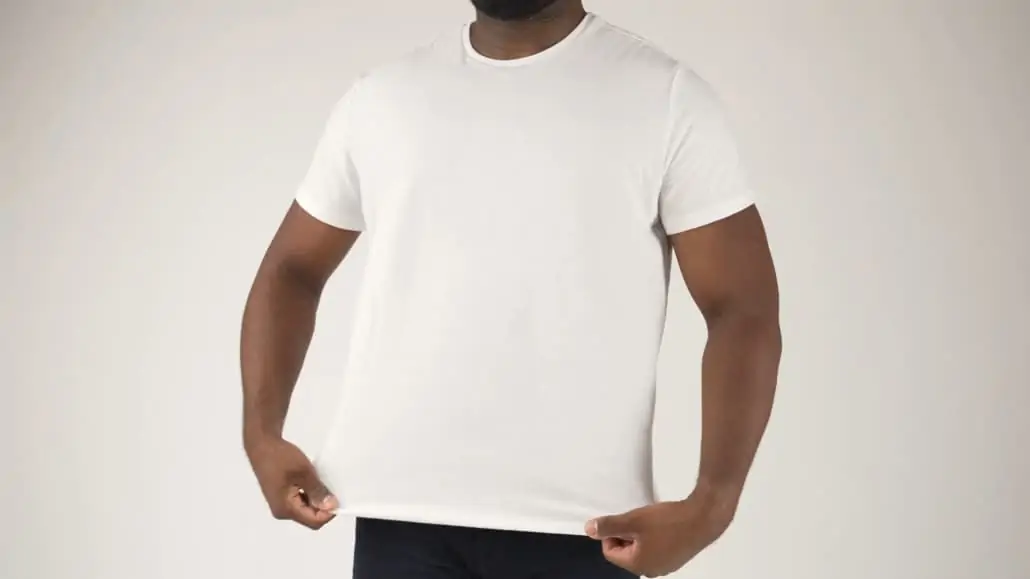
Finally, a pair of classic white sneakers round out this outfit perfectly, mirroring the white of the T-shirt, without adding unnecessary contrast.
Outfit #3: OCBD shirt, grey trousers, suede chukkas
If you’re looking to add some elegance to your denim jacket ensemble, then pairing an Oxford cloth button-down shirt with trousers is a great way to possibly dress things up.
When selecting your trousers, try to avoid super formal fabrics; things like worsted wool, as something like this might look a bit odder against a denim jacket. Instead, go for something like a flannel, a gray tweed, or perhaps even a chino, as these have more texture to help balance formality.
The Oxford cloth button-down shirt is a staple in the classic wardrobe and it’s another American clothing icon, just like the denim jacket is. It works so well for this look as it rides that line between casual and formal so well. To keep at this great balance, skip the tie for this look.
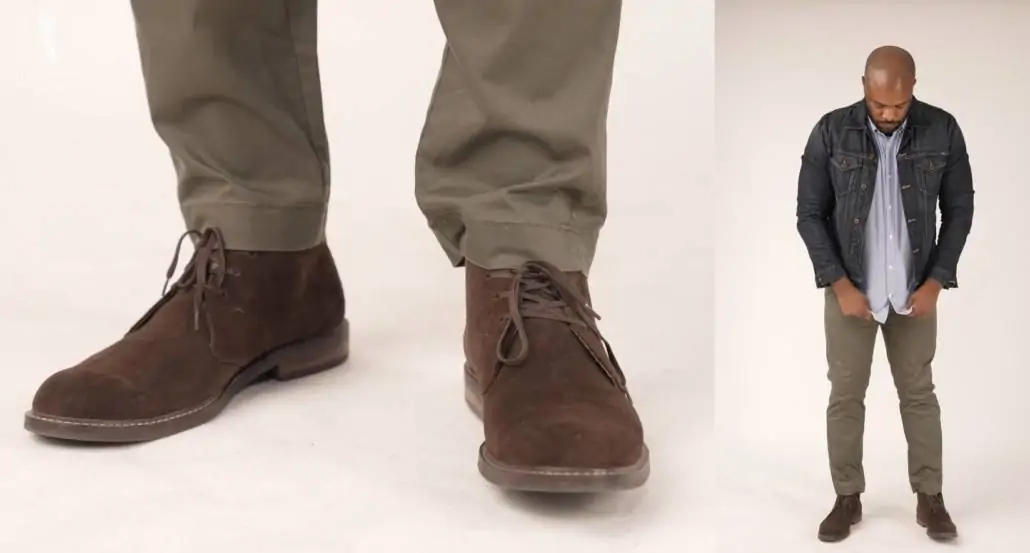
Finally, a pair of brown suede chukka boots help round out the outfit. The suede texture lends less formal air, while the simple lines keep everything clean and polished for this look.
How To Wear A Denim Jacket When It’s Hot
Outfit #4: Sport shirt, shorts, boat shoes
One of the great things about a denim jacket that’s tested apart from other lightweight jackets is the ability to wear it even when it’s warm outside. A great function here is actually in rolling the sleeves, and this can actually be done without it looking odd. For the first warm-weather outfit, that’s exactly what we’ve done.
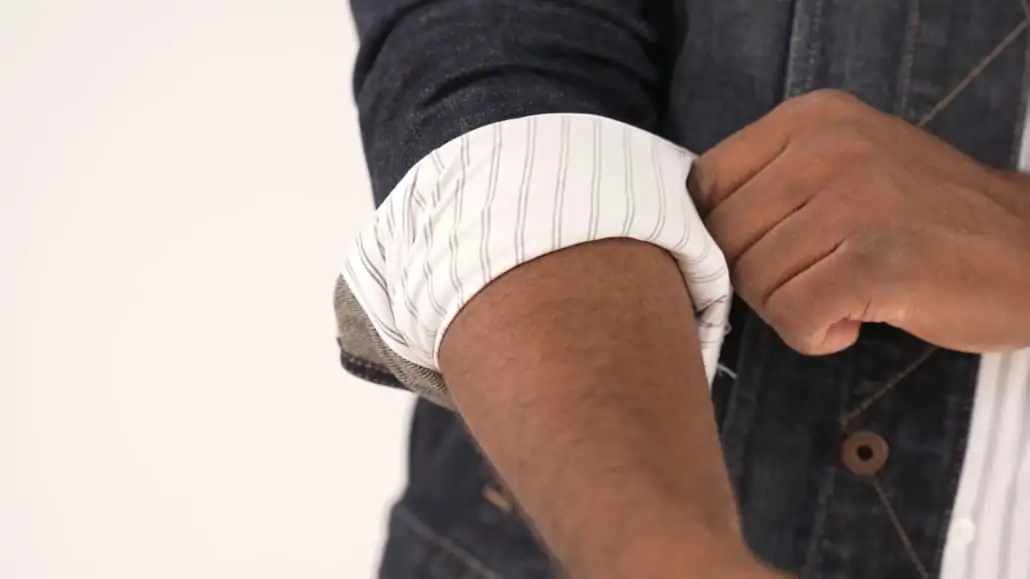
We’ve paired it with a striped sport shirt, a bold pattern like a stripe or a check can make this look sing. While the button-up nature of the shirt can make you look well put-together, a pair of classic shorts are added to emphasize the warm-weather vibes, accessorized with a belt, perhaps one that actually matches your shoes. The classic pair of boat shoes help round out the entire outfit as a warm-weather must-have.
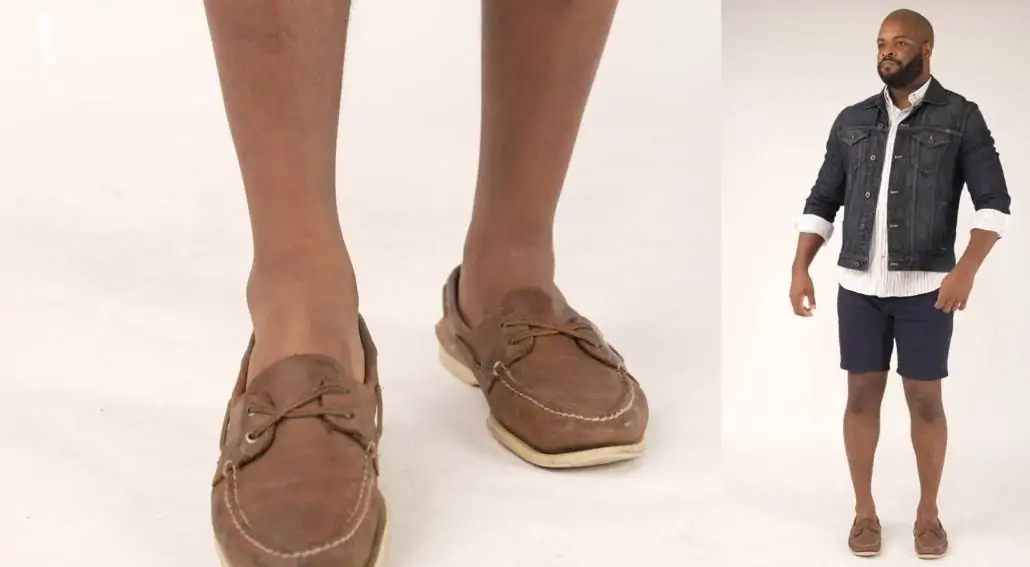
Outfit #5: White T-shirt, shorts, loafers (sockless)
For our next look, we’re keeping the sleeves rolled. Let’s replace the button-up shirt with the white T-shirt from earlier. This keeps the outfit clean and simple, and presents a much more effortlessly put-together aesthetic.
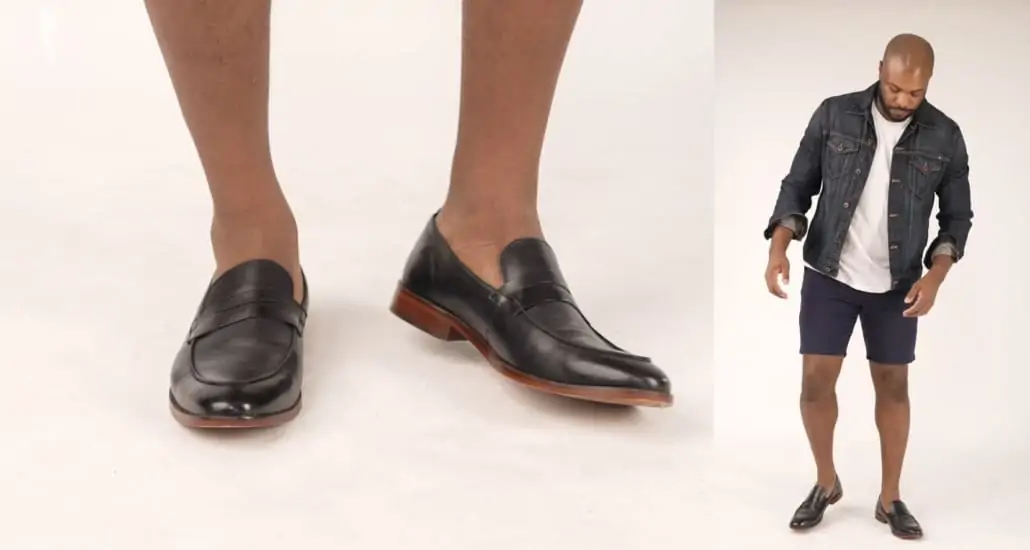
To complement the crisp white tee, we’ve added a contrasting pair of dark loafers. As you probably know by now, I love the sockless look, but I highly recommend it here as it keeps the outfit harmonious, and will assist you in feeling cooler than if your ankles were covered.
How To Wear A Denim Jacket When It’s Cold
Our last outfit category today is wearing the denim jacket when the weather isn’t so forgiving.
Outfit #6: Dark jeans, OCBD shirt, casual tie, suede boots
For our first cold-weather outfit, we’re bringing back the dark denim jeans from our very first look, and we’re going to pair it with an Oxford cloth button-down shirt.
To add a layer of warmth, you could also consider adding a knitted vest. This would also be a great way to smarten up the outfit. This can be done without looking too serious, and, of course, can help keep you at a comfortable temperature.

This look is brought together with the addition of a casual tie. I know that might sound like an oxymoron but trust me on this one. By choosing a casual texture like a knitted tie, a shantung silk, or a wool tie, you can actually elevate the entire outfit, all without looking too stuffy.
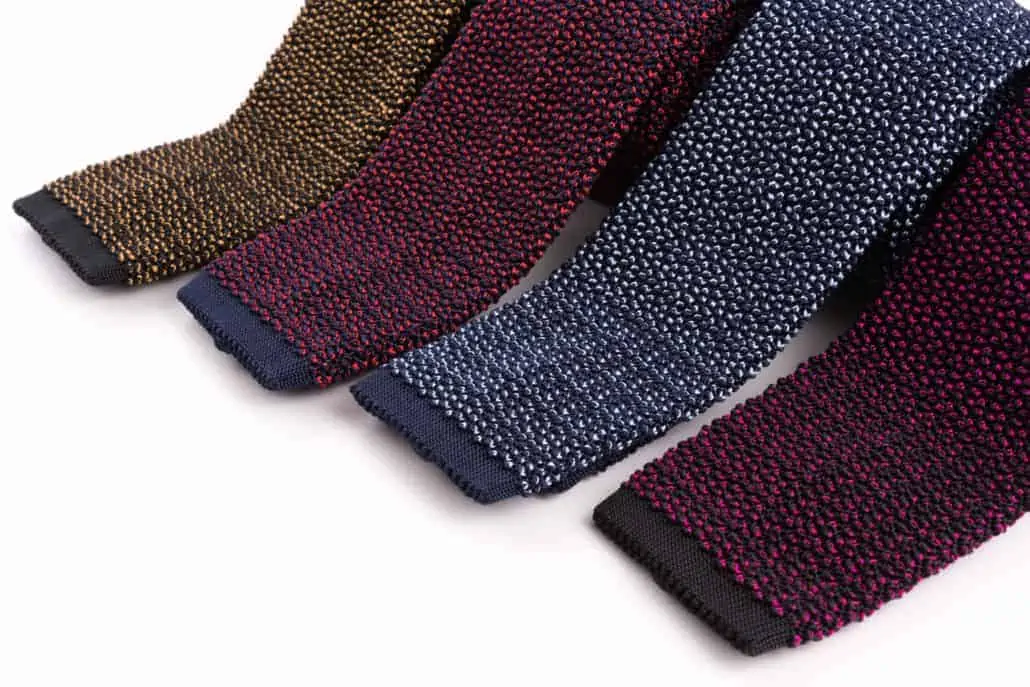
For footwear, the suede boots are back. The suede actually performs well in wet weather. The simple elegant lines of a Chelsea boot or in a chukka boot are great in this outfit.
Outfit #7: Turtleneck sweater, chinos, suede boots
Moving on to a stylishly simple outfit for colder weather, we’re pairing our denim jacket with a turtleneck sweater underneath this time. There’s nothing more comforting than a piece of knitwear when the mercury drops. So, we put it front and center. Not only will it keep you cozy, but it frames your face as well.
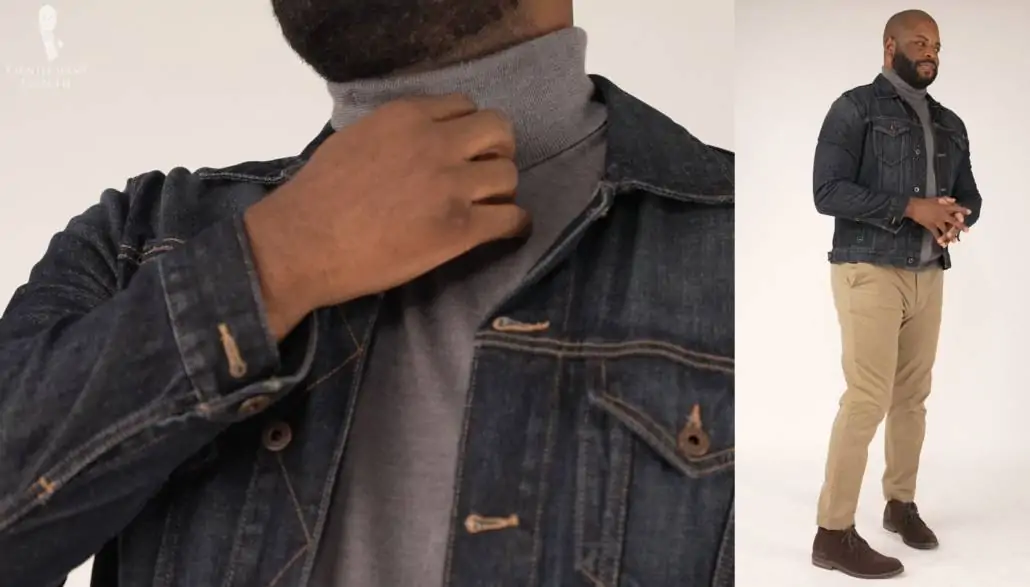
We’re bringing back the chinos in this look, as they’re dressier than jeans; not so dressy that they’re actually out of place. Plus, as we’ve already discussed they’ll look great with a denim jacket. And just like with our previous outfit, the suede chukka boots reign supreme.
Outfit #8: Overcoat, OCBD shirt, flannel trousers, dress shoes
Our last look is a more daring denim jacket outfit, but I’m sure you’ll want to try it yourself. The idea of this look is to use the denim jacket as a middle layer between an Oxford cloth button-down shirt and an overcoat.

For this outfit to work well, the overcoat needs to be at least knee-length, that enough difference is given to make it look intentional. We’re not going for a ‘the heating is broken and I’m wearing everything I own’ look.
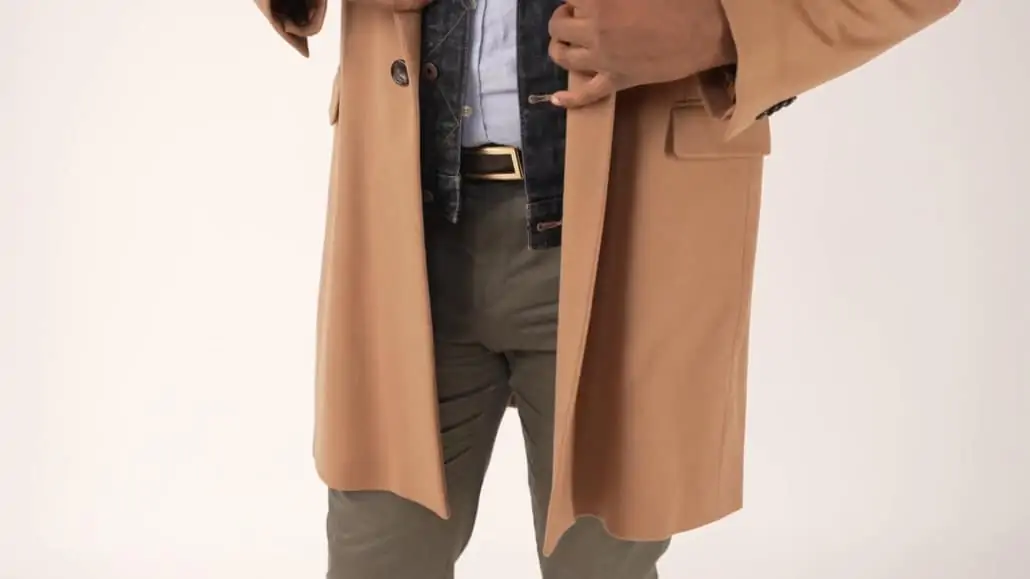
As the overcoat will give the ensemble a more dressed-up feel, skipping the tie will help balance things out and will provide the ability to wear the chinos from before. To finish off this look, the brown dress shoes add an overall refined edge.
Outfit Rundown
Today I’m wearing a dark blue denim jacket from Lucky, a blue button-down shirt with a white t-shirt, blue jeans, and a pair of dark brown chukka boots. And of course a pair of Fort Belvedere brown shadow stripe socks. Check out the Fort Belvedere shop here for socks like these.
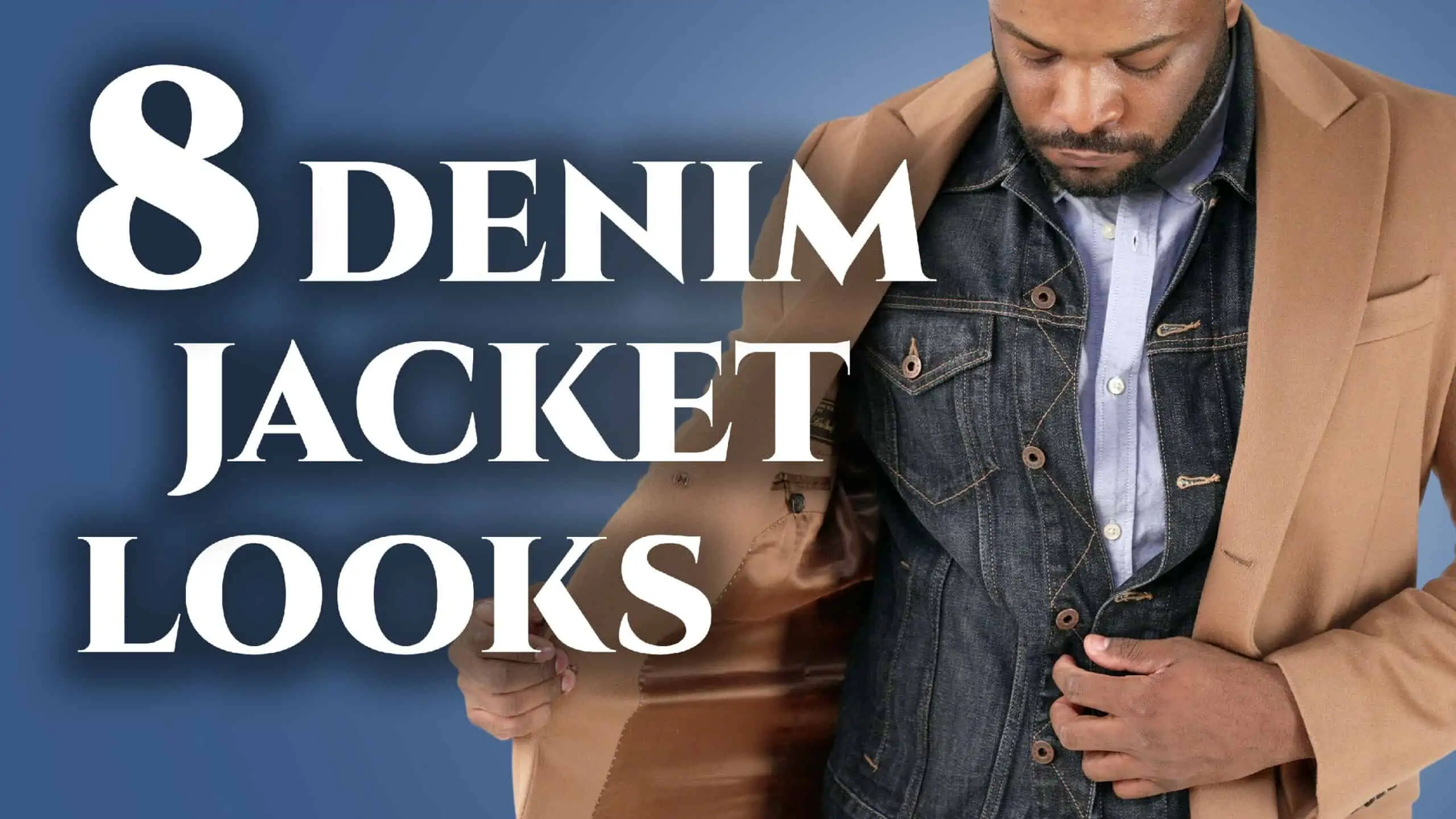
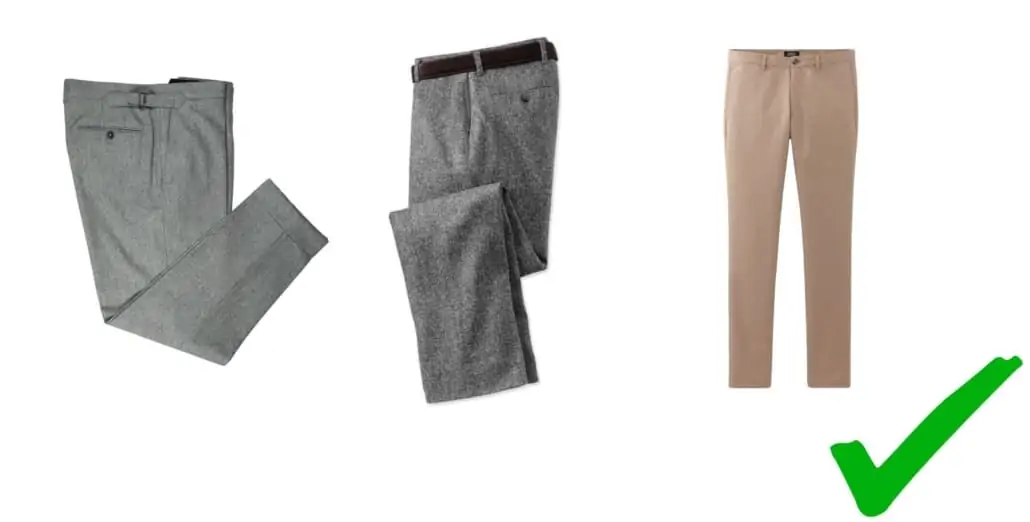
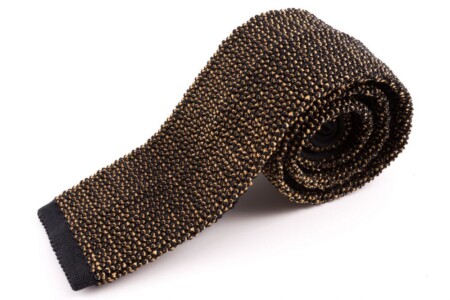
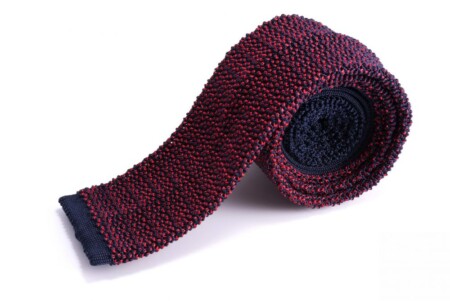

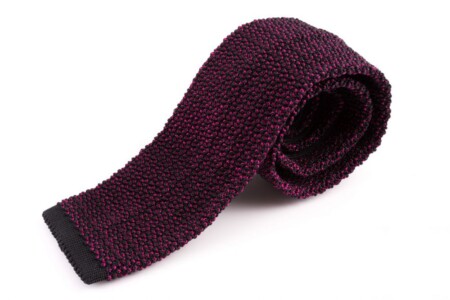
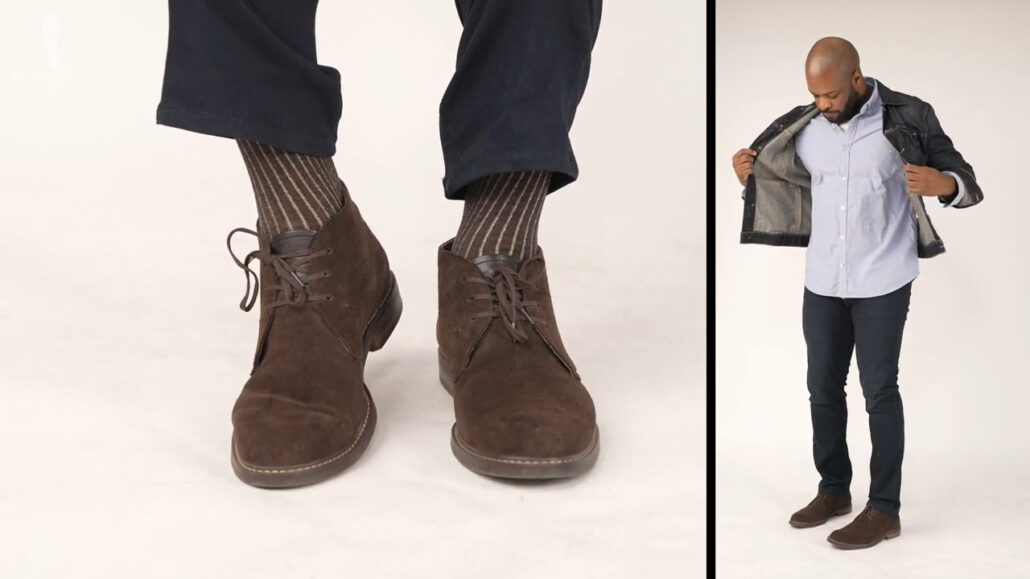
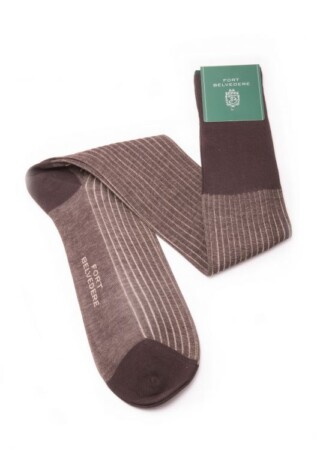
During the late 70’s Levis manufactured a version of it’s denim trucker jacket with an extension of denim to the jacket that would equal than of a sport coat. The jacket had dual vents which seemed to keep up with the ‘Leisure Jacket’ trend of the time. The jacket matched up with regular jeans and chambray shirts and moccasin worked while in grad school. The jacket had some good pockets which were handy for all those extras that one needed to carry…73s
I have questions regarding terminology. I believe that “button down” is a collar, not a shirt. A shirt is “buttoned-up”. Also, why is a desert boot referred to as a chukka? When I was young, I saw boots known as chukkas that had stitching on top of the toe. Now it seems that all ankle boots are called chukkas. And a denim jacket is now called a “trucker”? When did that happen?
I think it’s due to ignorance of clothing manufacturers and fashion retailers. Like those who use the terms ‘chinos’ and ‘khakis’ interchangeably even using the term ‘chinos’ to describe any pants in khaki colour, including ones like cargo pants.
I don’t think it’s ignorance, rather a subject of how different terms have stuck in different regions. In the example of chinos and khakis, the term “chinos” is far more popular in the UK and much of Europe to reference semi-casual brushed cotton trousers of any colour, including the traditional stone/beige shades. Khaki is then used to refer to a colour range closer to the types of camouflage greens used in military clothing.
Realistically, when discussing clothing, context is key. Most people will come to the same outfit when given the run down of “denim jacket, white t-shirt and chinos/khakis”, and even if there’s confusion, it shouldn’t be too far from the intended outcome.
You are correct a button down referring to collars. Desert boots ie, Clark’s, ( quality of them are extremely poor today ) were just desert boots. Never heard of chukka back then.
Denim jackets were referred to as dungaree jackets, not denim or trucker jackets.
What I think is weird is with other last years, the hooded sweat shirt is now a “hoodie.” Sounds silly.
Hi William, you are correct in the terminology of button-down referring to a collar. Although Oxford shirting cloth can be used to make any style of shirt, it is most commonly seen in the button-down collar style, hence the reference.
A chukka boot is a type of casual ankle boot with a derby style closure, as you can see in our article on the subject. The moccasin style stitching on the toe won’t change the chukka classification.
The trucker jacket is perhaps the most popular style of denim jacket on the market. Referring to a denim jacket as a “trucker” jacket is much the same as how “Coke” is used to refer to popular soft drinks – just the product of good marketing and popularity among consumers.
What I think is weird is that within the last few years, the hooded sweat shirt is now a “hoodie.” Sounds silly.
Levis introduced the type II jacket in 1953. The type III jacket was introduced around 1962.